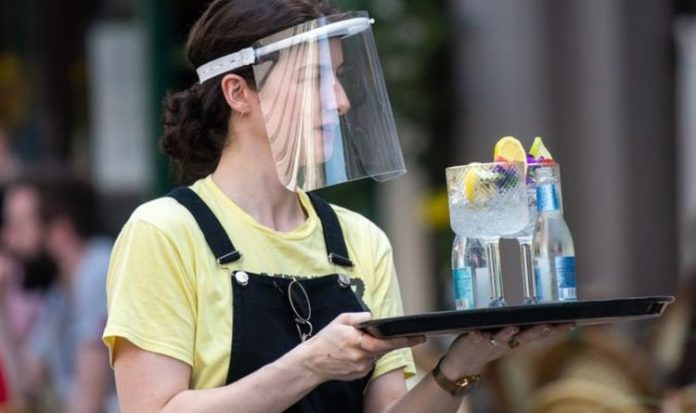Plastic face shields have been recommended by industry experts to wear alongside face masks as protection during the COVID pandemic. Hairdressers, barbers, nail technicians and tattooists have been advised to wear them alongside a face mask.
Doctors, nurses and other hospital workers on the frontline also wear face visors but with the addition of a fitted surgical mask.
But now, a computer simulation has revealed almost 100 percent of airborne droplets smaller than five micrometres in size can escape through the plastic visor when talking and breathing.
Worryingly, half of larger droplets given off by coughs and sneezes can also escape into the air, posing a risk to others and potentially spreading the virus.
This means solely wearing plastic face shields would not offer vital protection from coronavirus.
Makoto Tsubokura, team leader of the study carried out by the Riken Centre in Japan, told the Guardian: “Judging from the results of the simulation, unfortunately, the effectiveness of face guards in preventing droplets from spreading from an infected person’s mouth is limited compared with masks.
“This is especially true for small droplets off less than 20 micrometres.
“At the same time, it somehow works for the droplets larger than 50 micrometres.”
Professor Tsubokura said those who cannot wear face masks due to underlying health conditions could wear face shields.
But he insisted they only be worn in outdoor or indoor settings which are properly ventilated.
READ MORE: Six months of lockdown: All the key dates and events of the pandemic
A mannequin was then set up to expel the droplets and although face shields were found to stop the initial forward motion of the droplets, other particles were able to escape.
Professor Manhar Dhanak, the co-author of the study, said: “From this latest study, we were able to observe that face shields are able to block the initial forward motion of the exhaled jet, however, aerosolised droplets expelled with the jet are able to move around the visor with relative ease.
“Over time, these droplets can disperse over a wide area in both lateral and longitudinal directors, albeit with decreasing droplet concentration.”
Lead author, Professor Siddhartha Verma added: “Face shields have noticeable gaps along the bottom and the sides, and masks with exhalation ports include a one-way valve which restricts airflow when breathing in, but allows free outflow of air.
“The inhaled air gets filtered through the mask material, but exhaled breath passes through the valve unfiltered.”
Although the virus has been globally recognised for nearly a year, it is still unclear exactly how the virus spreads.
The New and Emerging Respiratory Virus Threats and Advisory Group (NERVTAG) and the Environmental and Modelling group (EMG) say airborne transmission plays a part in the spread.
Their paper said: “Based on the current evidence, it is possible that transmission through aerosols could happen where a person who generates significant amounts of virus is in a poorly ventilated space with others for a significant amount of time.”
The UK has the highest infection rate across Europe with the death toll surpassing 40,000.
Fears of a second wave have been raised again as new daily cases continue to rise.







